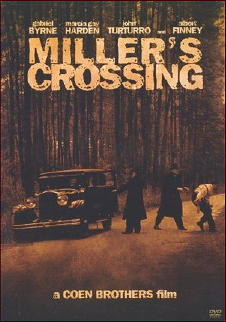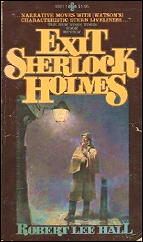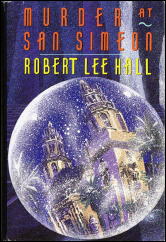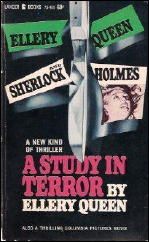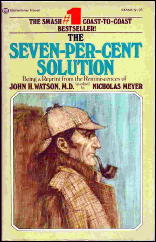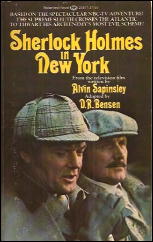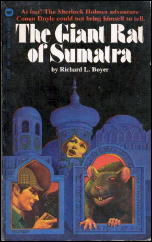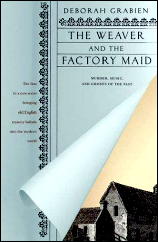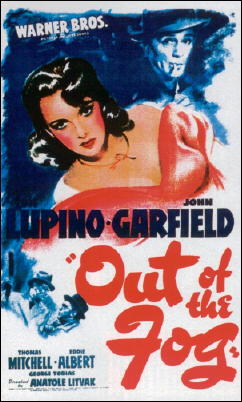July 2011
Monthly Archive
Tue 12 Jul 2011
RESULTS, INC. Mutual Broadcasting System. 30 minutes. October 7, 1944 through December 30, 1944. Sustaining (no sponsor). Recorded in Hollywood. Aired nationally. Three episodes are known to have survived. Created by Lawrence Taylor. Cast: Lloyd Nolan (Johnny Strange) and Claire Trevor (Theresa “Terry” Travers).
Results, Inc. was a comedy mystery radio series featuring film stars, Lloyd Nolan and Claire Trevor. The pair promised to solve any problems, from finding a missing uncle to filling out your crossword puzzle.
Johnny Strange was the typical “wise guy,” full of bravado and sarcasm. Before he started his new business, he had been a trombone player for a traveling circus, reporter, deck hand on a freighter, and a detective.
Terry Travers answered his ad for a secretary and assumed the job’s duties before Johnny could say a word. Terry would become secretary and Vice President, as well as the only other staff member besides Johnny, President of Results, Inc. She was the female equal of the “wise guy,” beautiful, blonde, and brassy. Her past included jobs as reporter, lingerie model, magician’s helper, and secretary to a producer.
Johnny was impressed by her job as a secretary to a producer “right in the lap of the entertainment field.”
“No, on the lap,” said Terry.
The cases would sound silly or harmless but always lead to Johnny and Terry’s lives in danger. Villains seemed to be proactive in revealing themselves, so suspects and clues were often gratuitous. But it was the humor of the situations and the interaction of the characters that was the series’ main appeal.
According to the radio logs of the New York Times and the Los Angeles Times, New York (WOR) and Los Angeles (KHR) aired Results, Inc. every Saturday except November 4th when a speech by President Roosevelt pre-empted programming. Thus, it is likely twelve episodes aired in the thirteen weeks the show was on the air.
According to radio historian and author Jack French, the series had many production changes during its short life. It is odd the series’ creator, Lawrence Taylor was not credited for writing the first (or perhaps any) episode. But he may have been busy with WWII. Billboard (October 7, 1944) referred to Results, Inc.’s writer as “Sgt. Larry Taylor.”
While not the best of the radio’s comedy mystery genre, Results, Inc. had more than enough funny and exciting moments to satisfy any comedy mystery fan. A lack of a sponsor and the busy schedule of the two movie stars were the most likely reasons for the program’s short life.
EPISODE GUIDE:
“Haunted House” (October 7, 1944). Written: Leonard St. Clair. Johnny starts Results, Inc and hires Terry. Their first case is a little old lady who wants them to find her a haunted house, preferably with a ghost included. The client writes gruesome mysteries and is looking for a place with atmosphere to inspire her.
“Bloody Gillettes” (December 16, 1944). Written: Leonard St. Clair and “Stewart Sterling.” Terry’s hairdresser is the last surviving member of a deadly family feud and has been offered money by a reporter to pose for a picture. But the hairdresser does not believe he lives up to the proper image of the tough Gillettes. Terry volunteers Johnny to pose as the last Gillette, and Johnny soon finds himself the last target of the feud.
“Queen Sheshack,” aka “Mummy Walks” (December 30, 1944) Written: Sol Stein and Martin Wirt. While arguing over how to spend New Year’s Eve, Johnny and Terry are hired by a night watchman at the local museum. He needs them to sit up with him and make sure the mummy does not walk off when he falls asleep.
SOURCES:
Places to listen to episodes for free:
My Old Radio (free membership is required):
http://www.myoldradio.com/rare-shows/results-inc-the-haunted-house/1
http://www.myoldradio.com/rare-shows/results-inc-ep-1/1
http://www.myoldradio.com/rare-shows/results-inc-ep-2/1
Radio Detective Story Hour Ep. 81 “Bloody Gillettes.” http:/www.otr.com/blog/?p=42
Radio logs: http://www.jjonz.us/RadioLogs/
Private Eyelashes: Radio’s Lady Detectives, by Jack French. BearManor Media. Kindle edition.
Mon 11 Jul 2011
Dashiell Hammett’s The Glass Key
Becomes the Coen Brothers’ The High Hat
A Review by Curt J. Evans
MILLER’S CROSSING. Twentieth Century Fox, 1990. Gabriel Byrne, Marcia Gay, John Turturro, Jon Polito, J. E. Freeman, Albert Finney, Mike Starr, Al Mancini, Richard Woods. Story: Joel Coen & Ethan Coen; & Dashiell Hammett (uncredited). Director: Joel Coen (& Ethan Coen, uncredited).
The best adaptation of Dashiell Hammett’s highly-regarded hardboiled novel The Glass Key, the Coen Brothers’ Miller’s Crossing, does not even have Hammett’s name attached to it. But it’s Hammett all right. Hammett all over.
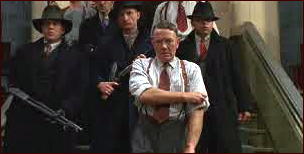
Characters’ names have been changed (to protect the guilty?), but many of the fundamental relationships of the novel survive intact:
â— There’s the central Tom Reagan (Gabriel Byrne)/Leo (Albert Finney)/Verna (Marcia Gay Harden) “love/loyalty triangle.†This equals Ned Beaumont/Paul Madvig/Janet Henry from the book.
â— There’s Leo’s rival gang leader, who attempts to usurp his place, Johnny Caspar (John Polito). He’s Shad O’Rory in the book.
â— There’s Caspar’s/O’Rory’s scarily violent homosexual sidekick, Eddie Dane (J. A. Freeman). He’s Jeff in the book.
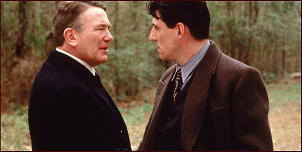
â— And there’s Janet Henry’s “degenerate†brother, Bernie Bernbaum (John Turturro). He’s Taylor Henry in the book (though in the book he’s belly-up when the action starts).
Tom Reagan/Ned Beaumont is still a tight-lipped, ambiguous character, who keeps us guessing as to the exact nature of his thoughts and emotions. He has debt to a bookie to be concerned about but he also seems to have genuine feelings for Leo/Paul and Verna/Janet (indeed, in the film there is an ongoing physical relationship between Tom and Verna, strengthening this element from the book).
Tom’s conflicting loyalties, his feelings of honor and his attitude to violence are at the center of the film, just as they are in the book. And he sure gets beaten just about as much!
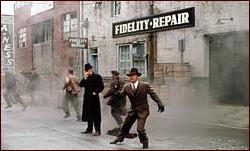
The symbolic dream of the glass key (discussed by Ned and Janet in the book) has disappeared, to be replaced by a symbolic dream of a flying hat (discussed by Tom and Verna).
Throughout this film the Coens are obsessed with hats. The film opens with a focus on a hat and closes with a focus on a hat. Tom is always losing his hat (usually while getting slapped/shoved/punched) and trying to recover it. Caspar is angered when Leo and Tom give him “the high hat†(i.e., act superior). He wants to be the one wearing the hat in Leo’s gangland kingdom.
Obviously the male hat is a symbol of power and authority. This reading is strengthened by the fact that the murder of one Leo’s henchman, Rug Daniels, results in the fallen Rug losing not only his hat but his hair (the toupee he wore).
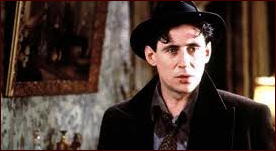
Rug, incidentally, replaces Taylor Henry from the novel as the opening murder victim, giving his cinematic doppelganger, Bernie Bernbaum, a stage upon which to strut his nasty ways. John Turturro, who plays Bernie, performs splendidly in this capacity.
Also more memorable than his book counterpart is John Polito’s Caspar, who almost steals the show from his fellow performers — all of whom are terrific — with his colorful performance and his frequently expressed, heartfelt concern over the sad decline in gangster ethics.
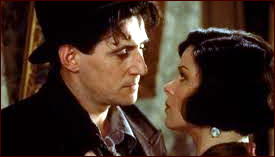
J. A. Freeman’s Eddie Dane is not necessarily superior to the novel’s Jeff, but he’s unforgettable in his own right. “The Dane,†as he’s called, is smarter than Jeff and also openly homosexual (somehow “gay†simply doesn’t seem the right word for this darkly malevolent guy), being involved in his own love triangle involving Bernie and another, rather swishy character named Mink (Steve Buscemi, underused) — a plot element very important to the film’s story. In the novel and the 1942 film Jeff’s homosexuality seemed sublimated and twisted in the beatings he so enjoyed giving Ned.
While the Coens keep many of Hammett’s central concerns, they jettison class issues completely (Verna ain’t the daughter of an aristocratic senator and she certainly ain’t no lady) in favor of ethnic ones. Divisions among Irish (Leo and Tom), Italians (Caspar) and Jews (Bernie) are much emphasized in the film.
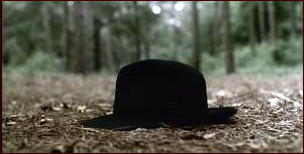
Certainly the Coens play up The Glass Key’s urban corruption angle as well, but it’s done in such a surreal, black comedy fashion it’s hard to take it too seriously as social commentary. (There’s no pretense in the film that duly elected government officials have any free hand whatsoever in determining anything that goes on in this city.)
What we are left with in Miller’s Crossing is the high hat. Which people will get to wear the hat, and how will they exercise the power that comes with it?
Anyone who enjoys Dashiell Hammett will want to see the answers the Coens come up with in this fine film.
Mon 11 Jul 2011
REVIEWED BY STAN BURNS:
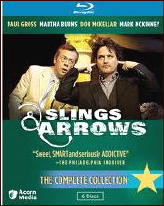
SLINGS AND ARROWS. Season One, 2003. Six episodes x 60m. Movie Central/The Movie Network, Canada; Sundance, US (2005). Paul Gross, Martha Burns, Stephen Ouimette, Susan Coyne, Don McKellar, Mark McKinney, Oliver Dennis.
I have just finished the first of three series of these (six hour shows each series). Basically this is a comedy with dramatic elements that takes place during a Shakespeare festival in Canada, and deals with vain and backstabbing actors, corporate sponsorship (they want to dump Shakespeare and put on “uplifting” shows like Mama Mia!), commercialism, and all the other stuff that goes on in a small provincial acting company.
At times I found them achingly funny, at sad moments compellingly moving. One of the characters is run over by a truck taking pigs to the slaughterhouse in the first episode (a hammy ex-actor whose is the festival’s artistic director).
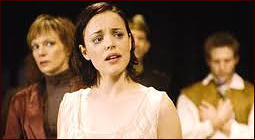
His ghost (Banquo’s ghost?) comes back to haunt the new interim artistic director of the festivalan actor whose Hamlet is considered one of the finest ever presented on stage, but was only seen by a only few as he had a nervous breakdown during the fourth performance and hasn’t acted in six years.
Considering how positive the reviews have been for Slings and Arrows, I am surprised I have never heard of it before. (In fact one of the reviews starts out this is the best series you have never heard of.) Produced for Canadian television, it was shown here only on the Sundance Channel, which I have never gotten.
While it is a little slow to start (a lot of characters and background are introduced in the first episode), by the middle of the second episode this “play within a play” had me rolling on the floor.
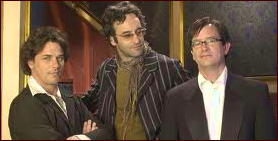
The first series is terrific, and the reviews say the second and third are even better. I am standing by my mailbox waiting for the next installment.
Terrific writing by people involved in Canadian theater, excellent acting – one of the stars is a young Rachael McAdams before she was “discovered” by Hollywood and went on to make Mean Girls and The Notebook in the next few years.
Series One rating: A.
Sun 10 Jul 2011
ROBERT LEE HALL – Murder on Drury Lane. St. Martin’s, paperback reprint; October 1993. Hardcover edition: St. Martin’s, November 1992.
Checking back over Hall’s career, he seems to have worked exclusively in the historical mystery subgenre. In doing so, he has also been no slouch in choosing either his characters or the period settings he’s put them in. Here’s what I found, in terms of his crime-oriented fiction:
Exit Sherlock Holmes. Scribner’s, hc, 1977. Playboy Press, pb, 1979.
The King Edward Plot. McGraw-Hill, hc, 1980. Critics Choice, pb, 1987.
* Benjamin Franklin Takes the Case. St. Martin’s, hc, 1988; pb, 1993.
Murder at San Simeon. St. Martin’s, hc, 1988. No paperback edition.
* Benjamin Franklin and a Case of Christmas Murder. St. Martin’s, hc, 1991; pb, 1992.
* Murder on Drury Lane. St. Martin’s, hc, 1992, pb, 1993
* Benjamin Franklin and the Case of the Artful Murder. St. Martin’s, hc, 1994; pb, 1995.
* Murder by the Waters. St. Martin’s, hc, 1995; trade pb, 2001.
* London Blood. St. Martin’s, hc, 1997. No paperback edition.
The Ben Franklin cases of detection, of which Murder on Drury Lane is one, are marked with an asterisk. Sherlock Holmes made an appearance in Hall’s first mystery only. Murder at San Simeon takes place at the California mansion of William Randolph Hearst, with Marion Davies, Louella Parsons, Jean Harlow and Charlie Chaplin all making at least cameo appearances.
That leaves The King Edward Plot, which takes place in England in 1906, during the reign of Edward VII, and one online source describes it as “the first novel-length story to feature Holmes as a character.†This does not appear to be so. Holmes’s appearance is not mentioned in a Kirkus review of the book, and the statement seems in itself to contradict the existence of Exit Sherlock Holmes.
Other mystery novels that Holmes had a role in and which also came before Hall’s first book are:
Ellery Queen [Paul W. Fairman], A Study in Terror, Lancer, 1966.
Michael & Mollie Hardwick, The Private Life of Sherlock Holmes, Mayflower (UK), 1970.
Nicholas Meyer, The Seven-Per-Cent Solution, Dutton, 1974.
Philip José Farmer, The Adventure of the Peerless Peer, Aspen, 1974.
Don R. Bensen, Sherlock Holmes in New York, Ballantine, 1976.
Richard L. Boyer, The Giant Rat of Sumatra, Warner, 1976.
Nicholas Meyer, The West End Horror, Dutton, 1976.
Austin Mitchelson & Nicholas Utechin, The Earthquake Machine, Belmont, 1976
– Hellbirds, Belmont, 1976.
I may have missed one or two, but I don’t believe many more than that. Keep in mind that this is a list of novels only, and that I deliberately attempted to avoid self-published works. Ever since 1977 (what happened then, timewise?) the dam has burst, and Sherlock Holmes has unquestionably become the one single fictional character, detective genre or not, who has appeared in the works of more novels by other authors than any other. (You can question the statement, if you like, as long as you can come up with an alternative.)
I seem to have gone off on a tangent here. The Sherlockian connection that exists in The King Edward Plot, and there is one, is that two of the four amateur detectives who uncover the plot reside at 221A Baker Street. One of them nicknamed “Wiggins.†I will have to read it.
Mr. Benjamin Franklin is getting restless, I am sorry to say. The book I have just read is about him, and he is being neglected. Here is a quote from page two. Franklin’s son William, a law student while in London, has just walked into the home where the Franklin entourage is staying, but he is unable to talk about the experience he has just had:
Mr. Franklin wore his customary brown worsted suit and black, buckled shoes. He sighed. “As my son’s voice appears disarmed, mine must slay the silence; viz.: he set by the law for the Theatre Royal in Drury Lane, where he saw the play. Some soubrette has stole his heart – and his tongue with it.†He lifted an inquiring brow. “Did I hit the mark? Did your enchantress dance in the pantomime?â€
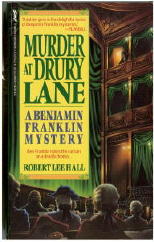
“Desdemona,†breathed William Franklin. “She played Desdemona.†He blinked, as if waking. “But, Father, I did not tell you that I went to the theatre. Indeed I have not been in my chamber since midmorning.â€
If Mr. Franklin’s explanation behind his deductive reasoning processes does not match that of the master, the attempt is well taken, at least by me, and the language is well appropriate for the tale that follows. Telling the story is Nick Handy, a twelve-year old lad who is Mr. Franklin’s illegitimate son. (Franklin made more than one trip to London, and there is a story behind this, one that was told in the first installment of the series. See above.)
To tell you the truth, the language, the vocabulary and the insight of the narrator is far beyond those of a twelve-year-old boy, but if you assume that Nick is rather precocious and add some sense of wonder, you will soon not notice.
The year, lest I forget to mention it, is 1758, and Drury Lane (as the title aptly suggests) is the center of the mysterious misadventures taking place. David Garrick hires Ben Franklin to investigate, who obligingly allows young Nick to tag along, making sketches of the various places they go and the people they meet.
It also turns out that Mr. Franklin is a pioneer in the field of fingerprints and handwriting analysis, but it is the later – with regard to the threatening notes that Garrick has been receiving – that is the more important of the two this time around.
The pace of the tale is leisurely, to say the least. Perhaps more important to the mystery, until the end, of course, are the sights and sounds of the theater itself, as well as the area and people around it, bit players included. Other famous personages have roles as well: Sir John Fielding, Dr. Samuel Johnson. Horace Walpole attends a play, as does Tobias Smollett.
A well-manufactured atmosphere has been created here, in other words, with a melodramatic ending that fits the mood perfectly. If the detection takes second place, it is only a minor quibble on my part to say so.
Sat 9 Jul 2011
IT IS PURELY MY OPINION
Reviews by L. J. Roberts
DEBORAH GRABIEN – Cruel Sister. St. Martin’s Press, hardcover, October 2006.
Genre: Paranormal/Mystery. Leading characters: Penny Wintercraft-Hawkes and Ringan Laine (4th in series). Setting: England.
First Sentence: Under a choking black fog, in which the air itself seemed composed of ash from the winter coal fires, a battered ten-year-old Austin Tilley lorry rumbled and bounced along Westferry Road on the south-eastern edge of London’s Isle of Dogs.
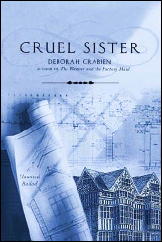
Folklorist, singer and restoration consultant Ringan Laine has been hired by his partner Penny’s brother and sister-in-law. They are building a large Elizabethan-style home on the Isle of Dogs next to the Thames.
Ringan’s first visit to the site makes him uncomfortable and second visit progresses to voices and visions. From there, things become rapidly worse as Penny fears she may lose Ringan forever to the past.
Having enjoyed the previous three books in this series, I selected this as my Halloween read last year, and am so glad I did. Grabien seamlessly blends the real and the paranormal; what is with what might be, and it works.
This isn’t icky, creepy stuff, but scary in the anticipation of what might happen. It is also not formulaic. I so appreciate that each book in the series handles the paranormal aspect in a different manner. That, alone, adds to the suspense.
One need not worry about starting this series at the beginning. Grabien establishes the background and history of previous paranormal experiences easily within the plot without slowing down the story. The dialogue is a little stiff at times, but the stories really are plot driven.
And a good plot it is. It’s not silly, fluffy or over the top. It starts out innocently enough and then builds. It is also the perfect balance of music, history, mystery and the paranormal; each of which I love and sent me to the internet after finishing the book. It delights me to learn new things and when I can’t easily tell what is factual and what is fictional because the story is so well done, it all seems true.
I found Cruel Sister completely engrossing; as in I read it straight through in four hours because I couldn’t bear to put it down. There is one more book in the “Haunted
Ballad” series, which I shall definitely read. Hopefully one day, there will be more.
Rating: Very Good.
PostScript: This is a clip of the ballad “Cruel Sister”: https://www.youtube.com/watch?v=1gAyqruWCfk&feature=related
The “Haunted Ballad” mystery series —
1. The Weaver and the Factory Maid (2003)
2. The Famous Flower of Serving Men (2004)
3. Matty Groves (2005)
4. Cruel Sister (2006)
5. New Slain Knight (2007)
The JP Kinkaid mystery series —
1. Rock & Roll Never Forgets (2008)
2. While My Guitar Gently Weeps (2009)
3. London Calling (2010)
4. Graceland (2011)
Sat 9 Jul 2011
Posted by Steve under
Reviews[8] Comments
REVIEWED BY TINA KARELSON:
ELLERY QUEEN – The Siamese Twin Mystery. Frederick A. Stokes, hardcover, October 1933. Reprinted many times, in both hardcover and soft, including Pocket Books #109, paperback, 1st printing, June 1941; Pocket #109, 10th printing, 1950 (shown).
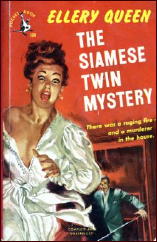
Ellery and Inspector Queen are driving back to New York from a vacation. Ellery takes an ill-advised shortcut over a mountain, and soon the situation is dire. Instead of the Mystery Machine, they’re in Ellery’s Duesenberg, but the other elements of a Scooby-Doo episode are all there: a treacherous journey leads to an isolated, spooky house — punctuated by an altercation with a frightening character who accosts them on the road.
When they approach the darkened house, they are turned away by a creepy servant, but soon the owner offers a slightly more gracious welcome. John S. Xavier, a well-known surgeon, his sultry wife and their guests seem to be hiding something, but they have no choice but to allow Ellery and his father to stay. There’s no escape for anyone, because the base of the mountain is ringed with a forest fire that is gradually creeping upward.
When the first murder occurs, Inspector Queen takes charge. The authorities can’t reach them until the fire is extinguished. As the flames come closer, the tension builds, causing Ellery and Inspector Queen to make some apparent errors, allowing the killer to strike again.
The Siamese Twin Mystery is very atmospheric, and the fire threat ratchets up the suspense. Will they correctly identify the killer? Is there more than one killer? And will any of them survive the fire? You’ll have to read it to find out.
Sat 9 Jul 2011
REVIEWED BY DAN STUMPF:
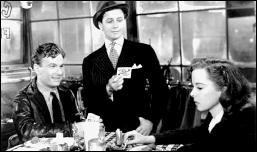
OUT OF THE FOG. Warner Brothers, 1941. John Garfield, Ida Lupino, Thomas Mitchell, Eddie Albert, George Tobias, John Qualen, Aline MacMahon, Jerome Cowan, Odette Myrtil, Leo Gorcey. Based on the play The Gentle People by Irwin Shaw. Director: Anatole Litvak.
After the three Paula the Ape Woman movies [reviewed here ] and moving on to things more criminous, I watched Out of the Fog, one of those movies that seem to typify a whole era; casting, story, sets and the overall feel of the picture somehow evoke the 1940s Warners “look” so completely, one gets lost in time just watching it.
John Garfield and Ida Lupino, those two echt-40s sub-stars, light the marquee on this one, he as a petty gangster and she as a pretty working girl, drawn to his shallow glamour and staccato sexuality, but the weight of the plot is carried by Thomas Mitchell and John Qualen as a couple of working stiffs leaned on by Garfield for protection money and finally summoning up the courage to rid the world of him — or so they think.
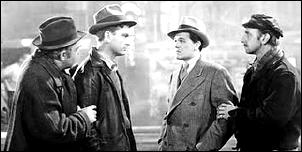
That’s the plot, but the charm of Fog lies in its stylish execution. Anatole Litvak, a Warner’s house director with a European touch, handles the actors well and moves the plot quickly, with some clever quirky moments, like murder plotted in a bath-house under the rantings of George Tobias as a loud-mouth émigré, or a tense interview with a bland and nasty assistant DA played with complete lack of charm by Jerome Cowan (of whom more later) and best of all, the scenes at night, on a foggy river, with Mitchell and Qualen in the foreground like figures out of Winslow Homer, while small boats blink at them and large ships pass in the rippling background — all shot on a studio set with the artistic camera of James Wong Howe, a cinematographer whose credits stretch from Shanghai Express to Hud and beyond, and who imparts a glowing intimacy to a genuinely likable film.
Fri 8 Jul 2011
A 1001 MIDNIGHTS Review
by Susan Dunlap
CATHERINE AIRD – A Most Contagious Game. Doubleday Crime Club, US, hardcover, 1967. Bantam, paperback, 1982. Rue Morgue, trade ppbk, 2007. First published in the UK: Macdonald & Co., hardcover, 1967.
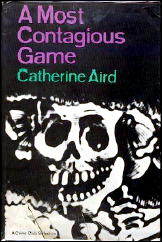
Catherine Aird excels at portraying the English countryside’s village life with all its petty prejudices, the gentry and near-gentry, and the castles and ruins that dot the landscape.
Her series sleuth, Inspector C. S. Sloan, deals with them in the fond yet frustrated manner of a native. Sloan is competent yet low-key, a good foil for the oddities of the suspects. His associates, Superintendent Leeyes, who views each case from the perspective of whatever night-school course he is taking, and Constable Crosby, whose only skill is fast driving, are rather forced and the least believable characters in the series.
Aird’s best work is outside the Sloan series. A Most Contagious Game gives us Thomas and Dora Harding, a couple portrayed with such fine strokes that they seem to have been taken whole from real life. At fifty-two, Thomas Harding has worked himself into a heart attack and subsequent retirement to an oddly restored Elizabethan country house.
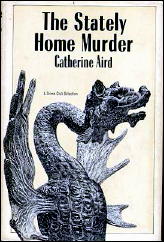
He is frustrated by the limitations his health imposes, and he is bored. Dora vacillates between encouraging his diversions and fearing he will bring another attack upon himself. The concerns of this couple and their interplay give the book a very solid base. But add to that Harding’s diversion — in tracking down the peculiarities of the remodeling of his house, he finds a secret compartment, a priest’s hole, and in it a 150-year-old skeleton.
Another body, this time of a young woman, is found, and Harding’s search for both killers leads him to the guilty secrets of villagers past and present.
Additional Aird titles are The Stately Home Murder (1970), Parting Breath (1977), Passing Strange (1981), and Harm’s Way (1984), all of which feature Inspector Sloan. Aird has also written a play and several works of nonfiction.
———
Reprinted with permission from 1001 Midnights, edited by Bill Pronzini & Marcia Muller and published by The Battered Silicon Dispatch Box, 2007. Copyright © 1986, 2007 by the Pronzini-Muller Family Trust.
Fri 8 Jul 2011
Posted by Steve under
Authors[2] Comments
Jamie Sturgeon has continued to search out details of the life of Richard Sheldon, author of Poor Prisoner’s Defense, a mystery novel published in England in 1949. Bill Deeck’s review appeared here on this blog earlier this week.
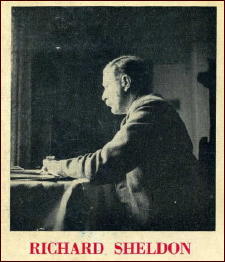
To this end Jamie has purchased a copy of Harsh Evidence, Sheldon’s second book and final crime novel, and with some success to show for it. A photo of the author is shown to the right, along with the biographical blurb I’ve transcribed and posted below.
There seems to be sufficient detail here to track down more about Richard Sheldon; indeed if more is learned that may be of general interest, I’ll report about it here.
A north-countryman by birth and residence, Richard Sheldon was educated at a North of England public school and at Oxford. His is in his “middle forties,” married, with one child. His recreations include forestry, shooting and fishing; he is interested in painting but not in music.
So much for conventional biographical details! They relate to a man who has at one time been a barrister, university Don, free-lance journalist, a rather amateurish soldier and even a member of a Rural District Council. Of all the occupations in which he has been engaged, Richard Sheldon finds writing at once the most exasperating, the most demanding and the most enthralling.
His first novel, Poor Prisoner’s Defence, published in 1949, was not written until he found himself for some months in a military hospital during the war. “Richard Sheldon is to be commended to the connoisseur of thrillers,” said the Daily Telegraph; while Maurice Richardson of The Observer wrote: “One of the most promising first crime stories for many months … Don’t miss!”
[UPDATE] 07-09-11. Jamie has just sent me a cover scan for Sheldon’s second book. Here it is:
[UPDATE #2] 07-15-11. John Herrington has inquired of Random House, current holder of the Hutchinson archives, and he reports back that “Richard Sheldon” is a pseudonym; his real name bears no resemblance to it.
(Random House cannot say more, because of a data protection act, or so I’m told.)
Wed 6 Jul 2011
Posted by Steve under
Reviews1 Comment
REVIEWED BY WALTER ALBERT:
PETER ROBINSON —
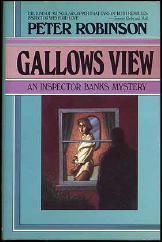
â— Gallows View. Viking, UK, hardcover, 1987. Scribner, US, hc, 1990; Avon, paperback, 1991.
â— A Dedicated Man. Viking, UK, hardcover, 1989. Scribner, 1991; Avon, paperback, 1992.
â— A Necessary End. Viking, Canada, hardcover, 1989; Viking, UK, hc, 1989. Scribner, US, hc, 1992; Avon, paperback, 1993.
â— The Hanging Valley. Viking, Canada, hardcover, 1989. Viking, UK, hc, 1990. Scribner, US, hc, 1992; Berkley, paperback, 1994.
In this British series featuring Chief Inspector Alan Banks, the latter has left London for the presumably quieter duties of a small-town, Northern England station (or whatever they call them in the UK).
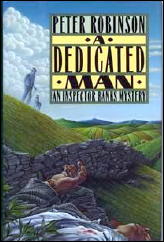
There are a couple of sergeants to do the routine chores and assist Banks in his investigations; a sympathetic superior (Inspector Gristhorpe) who doesn’t usually get In the way; an attractive, sympathetic wife (Sandra); two attractive, sympathetic children (who cares?); and a more than attractive and sympathetic psychologist who helped out on Banks’ first murder investigation and is still around in the most recent of the series, mighty appealing but not yet a serious threat to the comfortable, happy marriage.
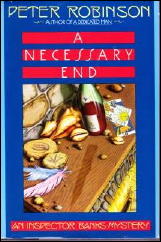
The peacefulness is deceptive and there are enough satisfying murders in the district to keep Banks on his mettle and to interrupt the weekend therapeutic stone-wall laying with Gristhorpe every so often.
The series is sober, solidly plotted and characterized. In these first four books Banks has not developed any annoying eccentricities: even his apparently recently acquired affection for opera seems to be giving way to folk music and less high-brow interests in the fourth book, The Hanging Valley.
The apparently unmotivated murder of a elderly widow; the brutal killing of a local archaeologist; the stabbing of a policeman that is not as it first appears to be random; and the bludgeoning of a vacationing academic give Banks varying opportunities to practice his methodical, even plodding work.
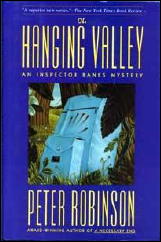
Although Banks pines momentarily (in The Hanging Valley) for “a nice English murder … just like the ones in books,” it might be noted that the basic premise of the plots is not too far removed from the enclosed world of the cosy, with its limited group of suspects.
In The Necessary End, the longest of the novels, an abrasive, ambitious, unsympathetic former colleague of Banks is sent down from London to lead the Investigation. Banks of course solves the crime, outperforming the flashy, unproductive methods of his rival.
The only memorable character so far is Katie Greenlock — in The Hanging Valley — and she supplies an ending that leaves any further comments by Banks (or Robinson) superfluous. It’s a haunting, horrific ending, and it has me looking forward to the next several novels in the series.
« Previous Page — Next Page »






